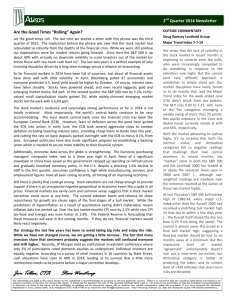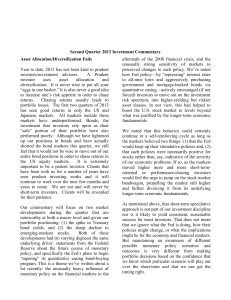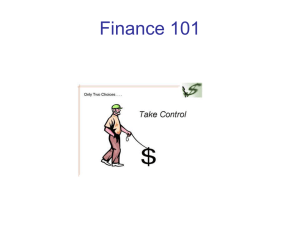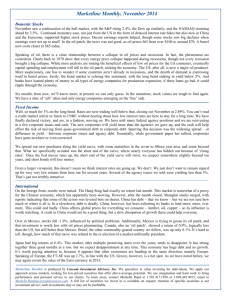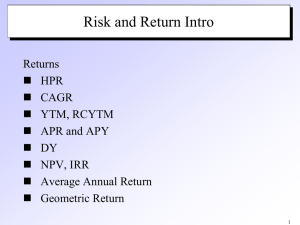1st Quarter 2012 Newsletter
advertisement
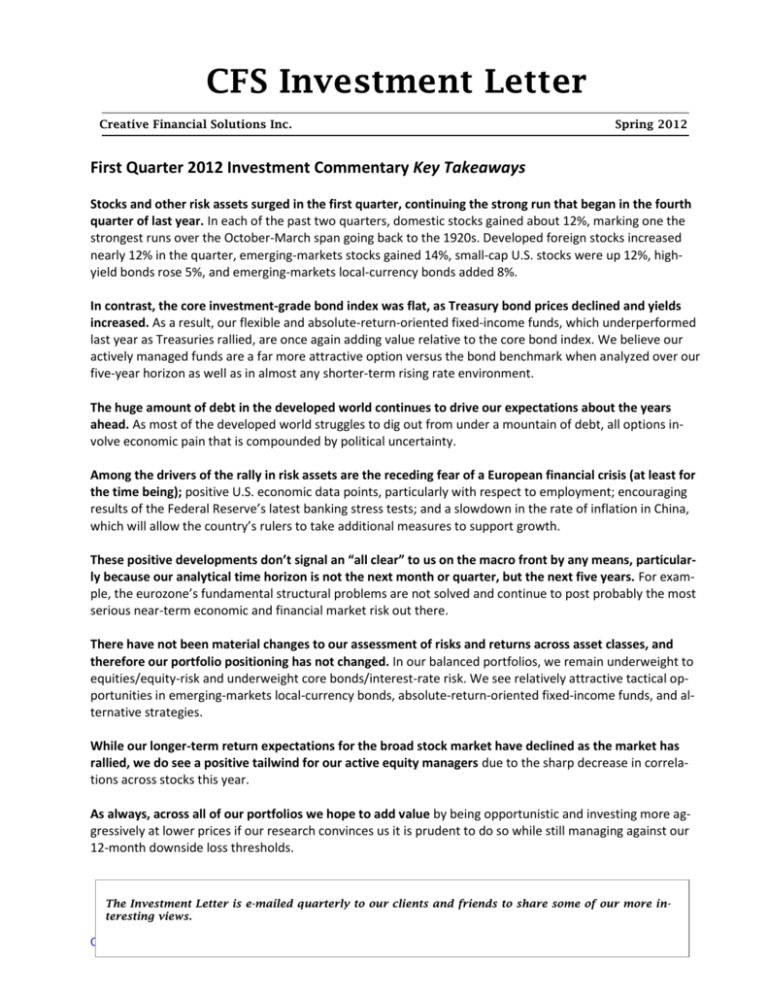
CFS Investment Letter Creative Financial Solutions Inc. Spring 2012 First Quarter 2012 Investment Commentary Key Takeaways Stocks and other risk assets surged in the first quarter, continuing the strong run that began in the fourth quarter of last year. In each of the past two quarters, domestic stocks gained about 12%, marking one the strongest runs over the October-March span going back to the 1920s. Developed foreign stocks increased nearly 12% in the quarter, emerging-markets stocks gained 14%, small-cap U.S. stocks were up 12%, highyield bonds rose 5%, and emerging-markets local-currency bonds added 8%. In contrast, the core investment-grade bond index was flat, as Treasury bond prices declined and yields increased. As a result, our flexible and absolute-return-oriented fixed-income funds, which underperformed last year as Treasuries rallied, are once again adding value relative to the core bond index. We believe our actively managed funds are a far more attractive option versus the bond benchmark when analyzed over our five-year horizon as well as in almost any shorter-term rising rate environment. The huge amount of debt in the developed world continues to drive our expectations about the years ahead. As most of the developed world struggles to dig out from under a mountain of debt, all options involve economic pain that is compounded by political uncertainty. Among the drivers of the rally in risk assets are the receding fear of a European financial crisis (at least for the time being); positive U.S. economic data points, particularly with respect to employment; encouraging results of the Federal Reserve’s latest banking stress tests; and a slowdown in the rate of inflation in China, which will allow the country’s rulers to take additional measures to support growth. These positive developments don’t signal an “all clear” to us on the macro front by any means, particularly because our analytical time horizon is not the next month or quarter, but the next five years. For example, the eurozone’s fundamental structural problems are not solved and continue to post probably the most serious near-term economic and financial market risk out there. There have not been material changes to our assessment of risks and returns across asset classes, and therefore our portfolio positioning has not changed. In our balanced portfolios, we remain underweight to equities/equity-risk and underweight core bonds/interest-rate risk. We see relatively attractive tactical opportunities in emerging-markets local-currency bonds, absolute-return-oriented fixed-income funds, and alternative strategies. While our longer-term return expectations for the broad stock market have declined as the market has rallied, we do see a positive tailwind for our active equity managers due to the sharp decrease in correlations across stocks this year. As always, across all of our portfolios we hope to add value by being opportunistic and investing more aggressively at lower prices if our research convinces us it is prudent to do so while still managing against our 12-month downside loss thresholds. The Investment Letter is e-mailed quarterly to our clients and friends to share some of our more interesting views. CFS Investment Newsletter First Quarter 2012 Investment Commentary Stocks and other risk assets surged in the first quarter, continuing the strong run that began in the fourth quarter of last year. In each of the past two quarters, U.S. stocks gained about 12%, marking one of the strongest runs over the October-March span going back to the 1920s. Developed foreign stocks increased nearly 12% in the first quarter, emerging-markets stocks gained 14%, small-cap U.S. stocks were up 12%, high-yield bonds rose 5%, and emerging-markets local-currency bonds added 8%. Treasury yields rose slightly in the first quarter, creating a headwind for investment-grade bonds, which are the core bond holdings in most balanced portfolios. As a result, our actively managed bond funds, which underperformed last year as Treasuries rallied, are once again adding value relative to the core bond index. Coinciding with the recent stock market rally, and after an extremely turbulent 2011, stock market volatility has subsided (although we would note that in the first quarter of 2011 volatility was similarly quiescent prior to spiking to new highs in the next two quarters). The Chicago Board Options Exchange Volatility Index, or VIX, is a commonly used indicator of market volatility. Often referred to as the “fear index” it is a measure of investors’ expectations of S&P 500 volatility over the near term. The lower the VIX the less fear or risk-aversion there is in the market. As of March 23, 2012, the VIX stood at its lowest level since July 2007, and was well below its long-term average reading as well. When the VIX reaches extreme levels it is often a good contrary market indicator, particularly when volatility is very high. That is, very high levels of volatility (fear) suggest the market may be nearing a bottom and vice versa. The VIX hit its recent peak right at the October 2011 stock market low, and it was also very high when we were adding to our portfolios’ equity-risk exposure in early August and late September. Of course, the ultimate peaks and troughs in any index or indicator can only be known in hindsight. What’s been driving this rally in global risk assets over the past several months? There are always a multitude of factors that drive financial markets over the shorter term, but from a fundamental perspective we’d highlight the following as among the key positive developments in recent months. » The receding fear of a European debt contagion/financial crisis, at least for the time being, due to a combination of the European Central Bank’s long-term refinancing operations, or LTRO, as well as other stimulative global central bank actions taken in late 2011 and early 2012. In late December and again at the end of February, the ECB undertook the LTRO, whereby they offered essentially unlimited three-year loans to European banks at a 1% interest rate and with easier collateral requirements. In total, over one trillion euros ($1.3 trillion) was borrowed by more than 800 financial institutions across Europe and the United Kingdom in the two LTROs. The December LTRO slowed, if not fully stopped, the adverse feedback loop of forced deleveraging among European banks that was gaining momentum last winter. The LTRO also had the effect of supporting the peripheral European sovereign bond markets (e.g., Italy and Spain), where interest rates had been rising sharply. Because the banks were no longer being forced to sell assets, and other market participants understood that the cycle of forced deleveraging had been halted by the ECB, the price of government debt rose and yields fell, reducing these countries’ borrowing costs. This is critical, as a country’s borrowing costs (the rate it pays on its sovereign debt) can have a huge impact on its ability to continue to finance its deficits and ultimately reduce its overall debt/GDP ratio. Italian and Spanish 10-year government bonds that had been yielding around 7% in late November were yielding 5% or less in early March. (However, the yield on Spanish debt moved sharply higher in late March/early April on renewed concerns about the severity of the Spanish recession and questions about the government’s ability or willingness to meet previously agreed-upon deficit reduction targets.) CFS Investment Newsletter » The successful Greek debt restructuring (their second bailout) in March, in which Greece was able to write off 107 billion euro of debt to private lenders, was another positive for sentiment about the European debt situation. » Positive U.S. economic data points, particularly with respect to employment. Nonfarm payroll employment rose by an average of 245,000/month during the three months from December through February, the largest gains since 2006; the unemployment rate has dropped from 9% in September to 8.3% in February, and; new claims for unemployment insurance recently hit a four-year low. » The results of the Federal Reserve’s latest banking stress tests, in which 15 of the 19 institutions passed, gave the domestic market, and financial stocks in particular, another boost. » A slowdown in the rate of inflation in China, which will allow the country’s rulers to take additional measures to support growth (e.g., by further easing monetary policy), boosting hopes they can engineer the hoped-for “soft landing” for the economy. These are all positive developments, but they don’t signal an “all clear” to us on the macro front by any means, particularly because our analytical time horizon is not the next month or the next quarter, but the next five years. As with all things macro, there is always an “on the other hand”— a contrary data point or opposing interpretation to almost any piece of new data. We highlight some of these counterpoints below because we think they should carry some weight in one’s assessment of the macro landscape. » While the LTRO and Greek debt restructuring appear to have taken the disorderly default risk and European debt contagion risk off the table for now, it does nothing to solve the fundamental structural problems of the eurozone. The LTRO provides the countries some additional time and space to try to implement necessary but extremely painful and difficult economic and political reforms. But, we are still not confident that they will do so—or, at least that they will do so without another financial crisis happening first (i.e., they may need to be forced into it). » The new Greek debt is currently trading at roughly 20 cents on the dollar, indicating the market is pricing in a high probability of yet another default/restructuring. Greece’s exit from the eurozone remains a significant risk that could lead to contagion across the eurozone. » With respect to the recent positive U.S. economic numbers: New York Federal Reserve President William Dudley recently noted that roughly half the decline in the unemployment rate was due to a decline in the labor force participation rate. Dudley also noted that while GDP growth of 3% in the fourth quarter was “stronger,” most of that growth was due to inventory accumulation, while final sales-growth was weak, which bodes poorly for first quarter 2012 GDP growth. He also pointed out that the unusually mild winter weather this year likely caused a temporary boost to overall economic activity, pulling forward spending and hiring that would otherwise have happened in the spring. » The looming U.S. “fiscal cliff”: In his recent congressional testimony, Fed Chairman Bernanke stated, “Under current law, on January 1, 2013, there’s going to be a massive fiscal cliff of large spending cuts and tax increases.” That is when the Bush-era tax cuts, the temporary payroll tax cut, and extended unemployment benefits are due to expire, and $1.2 trillion of automatic spending cuts begin to kick in—the result of last year’s Congressional Supercommittee’s failure to reach consensus. The impact would be a roughly 3.5% hit to GDP next year. It seems unlikely that it will actually play out that way without any modifications, but the risk of policy errors and political dysfunction, particularly in an election year, remains very high. » There is also the risk of a military conflict with Iran that could cause a major spike in oil prices and consequently a severe negative economic shock and stock market decline. As many commentators have pointed out, prior to the CFS Investment Newsletter 2008 financial crisis, the previous three global recessions (in the mid-70s, early 80s, and early 90s) were all preceded or precipitated by a sharp spike in oil prices. Have these recent macro and market developments changed our assessment of the risks/rewards across asset classes? There are always positive and negative data points and potential risks at every stage of an economic and market cycle. Rather than trying to predict what each new set of economic data will show, we instead try to assess what expectations the financial markets (stocks and bonds) are currently discounting within the context of our five-year time horizon. The developments noted above don’t lead to any material change in our current assessment of risks and returns, and therefore our portfolio positioning has not changed since the end of January. However, while our scenario analysis work and our tactical decisions are constructed with a five-year time horizon, we also need to be cognizant of the potential paths that the economy and markets might take over the nearer term to arrive at the five-year destination. This is particularly relevant for our portfolio risk management, where we stress-test each of our portfolios’ positioning against their 12-month time horizon. In the current environment, we can easily envision the first few years of the five-year horizon looking very different from the ending years—for example, in terms of inflation and interest rate risk (a relatively low risk up front, but potentially a big risk later on). Our discipline is to keep focused on the long term (when we believe fundamentals and valuations ultimately converge), while remaining flexible and nimble through this highly unstable, uncertain, and unprecedented macro environment. So how are we positioned and why? We continue to position our portfolios with a conservative bias relative to our long-term, strategic allocations. In our balanced portfolios, we remain underweight to equities/equity-risk and underweight core bonds/interestrate risk. We continue to see relatively attractive tactical opportunities in emerging-markets local-currency bonds, absolute-return-oriented fixed-income funds, and alternative strategies. As we’ve discussed previously, our reduction in core bond funds in favor of flexible bond managers and alternative strategies is to position our portfolios to generate better returns in this very low-rate environment and provide some protection when rates eventually begin to rise. However, our underweight in core bonds means we have a bit less protection from our fixed-income allocation in a severe market downturn. Conversely, our equity underweight means that if stock markets continue to rally in the near term, we expect not to participate as fully. We are willing to give up near term upside, not only because of our big-picture concerns, but also because even if these risks don’t materialize we believe it is most likely that returns for U.S. and developed foreign stocks will be relatively low over the next five years. We believe it will take many years to work through the huge buildup of debt that precipitated the 2008 financial crisis, and the result will be less spending and slower growth. While emerging-markets stocks’ long-term returns look reasonable on an absolute basis and attractive versus U.S. stocks on a relative basis, they will likely come with greater volatility over the shorter-term. When we weigh our outlook for stocks against our return expectations for positions we own like arbitrage strategies, which are funded from a reduction in stocks, we don’t think we’re giving up much upside and are getting greater stability in exchange. Looking out longer term, we expect to see more periods of heightened volatility along the lines of what we saw last summer and fall. These environments create opportunities to increase our weightings to riskier asset classes when they are priced at levels likely to generate much higher returns than at current levels. The managers we invest with are similarly seeking to generate superior returns over the longer term by taking advantage of shorter-term mispricing at the individual stock level. These opportunities can allow us to generate long-term returns that are better than just “what the market gives us.” CFS Investment Newsletter We’ll close with a reminder that we are in an environment with significant macro risks that are difficult to predict, and the range of possible outcomes is very wide. This makes it especially important that investors consider carefully how they might react in various outcomes and choose a strategy accordingly. Riskaverse investors should stay patient and resist the temptation to ratchet their risk level higher because markets “feel good” after a strong run. But investors with long time-horizons and the fortitude to ride out sharp shorter-term downturns can accept more risk. As always, across all the strategies we manage we’ll be adding to risk only when our research convinces us it is prudent to do so, and we’ll reduce risk (as we have currently) when we believe returns won’t be high enough to reward us sufficiently. Dave Repka CFS Investment Newsletter

